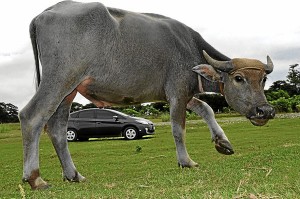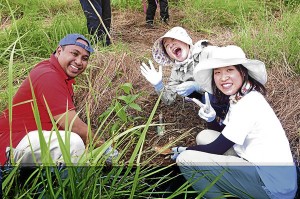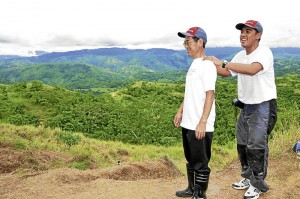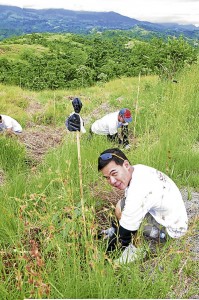Small earth, big heart

THE PRIUS OVERSHADOWED. Despite the noble efforts of auto firms like Toyota to produce environmentally sound vehicles, the second greatest producer of greenhouse gases, behind energy production, is the livestock industry, for which huge territories are cleared to give way to grazing lands. Photos by Tessa R. Salazar
PEÑABLANCA, Cagayan— They’ve been here three times in three years. Now on their fourth visit in as many years, volunteers from Toyota Motor Philippines and Toyota Motor Corp. from Japan seem as refreshed and invigorated as the first time they set foot in this valley-province approximately 500 km north of Manila.
The Inquirer Motoring team, which has covered this $3-million undertaking from manufacturing and transport giant Toyota since the second year of the project, has come along again.
This 2,500-hectare reforestation project is located in Peñablanca, on the outskirts of Tuguegarao, and rests at the foot of the Sierra Madre mountain range encompassing part of the headwaters of the Cagayan River. The river supports the country’s largest rice growing region, but deforestation in the area has contributed to downstream floods and droughts. Reforestation has been seen as essential to temper and nourish the river.
Just last Thursday, July 7, Toyota flexed its corporate muscle in its ecological effort to restore and re-vegetate a denuded Philippine forest, in a visible replica of its efforts in other parts of the globe. Here, more than 60 Toyota employees and volunteers from Japan and Singapore joined fellow volunteers from Toyota Motor Philippines to plant at least 40 tree saplings each on a mountainside in Peñablanca. And just like the last time, TMP invited this writer to drive the 3rd-generation Prius from Manila to Peñablanca and back—a total of over 1,000 km—to showcase the fuel efficiency and environmental soundness of the Prius Hybrid Synergy Drive.

COMING ALL THE WAY from Japan, Akiko Ichii and Sayaka Kozaki plant trees with a Filipino counterpart.
Volunteers from Tokyo
It wasn’t only the Prius who made the thousand-kilometer trip. Toyota showed the seriousness of its intent as it flew in volunteers from as far away as Tokyo. Two noteworthy volunteers, Akiko Ishii and Sayaka Kozaki, along with 10 other Japanese volunteers, endured the four-hour flight from Tokyo to Manila, and another hour-long flight for Tuguegarao, to plant the 40 or so tree saplings. They were also joined by three volunteers from Singapore, and local counterparts composed of employees of Toyota Makati, Bicutan-Parañaque, San Fernando Pampanga, Toyota Financial Services Corp, Toyota Autoparts Philippines and Lexus Manila Inc.
This has been the second batch of international volunteers that has taken part in the reforestation project.
Seeing the international volunteers literally dig in and get their hands dirty without getting a breather from the long trip, 50-year-old Conservation International driver Eddie Yadao remarked in Pilipino, “I hope people living here would stop cutting trees for firewood. The Japanese and Singaporeans came so far to plant trees for us. What if we were to plant trees in other countries, and the natives cut the trees to make charcoal? How would that make us feel?”
Conservation International supervises the reforestation project, and with the assistance of the Department of Environment and Natural Resources, exercises protective authority over the area.
By the end of the day, the volunteers had planted over 1,000 saplings, adding to the over 1,360,000 trees already planted during the first phase of the reforestation project from September 2007 to July 2010 on 1,772 hectares of protected land. These trees—narra, molave, bignai, kalumpit, tindalo, dapdap, tuai, hauili, tibbig and alibangbang—are indigenous to the area.
Forest rehabilitation
For phase 2 of the project which runs from September 2010 to 2013, the project will target the rehabilitation of another 728 hectares of degraded lands through reforestation, enrichment planting and agro-forestry.
To make the project sustainable for the local communities, and to veer them away from their destructive slash-and-burn farming techniques that caused the deforesta tion in the first place, the reforestation has focused on planting 40,000 mango trees and over 12,000 assorted fruit trees like citrus, coffee, cacao, langka, and 300,000 fuel wood species like ipil-ipil, anchoan and kakawate. In time, the communities can already literally start harvesting the fruits of their labor.
The project has become a protected zone. All participating farmers are instructed not to cut any tree from the natural forests. Certain fast-growing trees are designated for firewood, while rice hull is used to supplement firewood as fuel for cooking.
About 10 species of trees are planted mostly consisting of indigenous species from the fabaceae, myrtaceae and other families to create a forest that adapts well to the immediate environment.
“The target planting area is about 95 percent already,” said Ed Angadol of Conservation International. “The trees planted four years ago are now up to two meters high. The growth is slow because of poor soil quality in some areas.” he added.
Surface runoff
Small vegetation and grass have managed to trap sediments in the area, Angadol described, and the incidence of surface runoff and erosion coming from higher parts of the mountains minimized. The positive effect of more lush vegetation and thicker forest cover was observed last year. The topsoil, he noted, was “more intact” than they were several years ago, mainly because of the prevalence of tall grasses and, to some extent, the trees planted in the project area (check out “New forest helps save villages” at https://services.inquirer.et/print/print. php?article_id=20091102-233517).
Angadol said springs in the project site were holding water at much longer periods, an indication that the young forest was taking its hold on the water more than before.
Two weeks ago and 540 km south of Peñablanca, the media got a glimpse of the 82-hectare Toyota plant at Sta. Rosa, Laguna and its 11.4-hectare Eco Forest, a recognized global model wastewater treatment plant with a capacity to treat 840 cubic meters of industrial and sanitary wastewater per day. The size and significance of the Eco Forest caught even veteran scribes by surprise.
SoC-free vehicles
Another sustainable initiative of the manufacturing plant included the acquisition of SoC-free vehicles (SoC means “free from substance of environmental concerns”). SoC-free vehicles are free from lead, mercury, hexavalent chromium and cadmium.

TMP’s Patrick Senon and senior vice president Kyoji Inuzuka partner in calisthenics before resuming the ‘backbreaking’ work of planting tree saplings.
The Toyota plant is also the first auto company in the country to harness solar power in its operations. The system currently supplies power to the Toyota activity center’s lights.
The plant is also in the middle of efforts to reduce VOCs (volatile organic compounds): Paints and thinners are the primary sources of VOCs. Robots have been used in the painting process to minimize VOC emission.
TMP became the first ISO 14001-certified company in the auto industry, and the 7th in the Philippines. And as this plant in Laguna grows cleaner, Toyota’s trees up north grow more robust and multiply. Somehow, we’ll never get tired shuttling back and forth between these two locations in a Prius.

